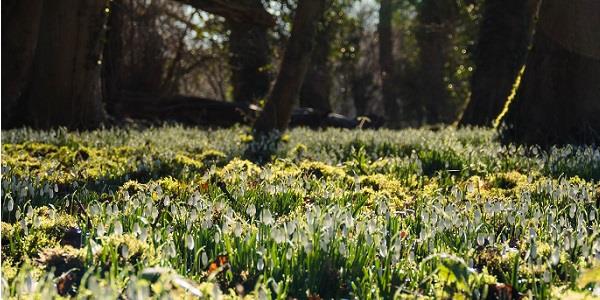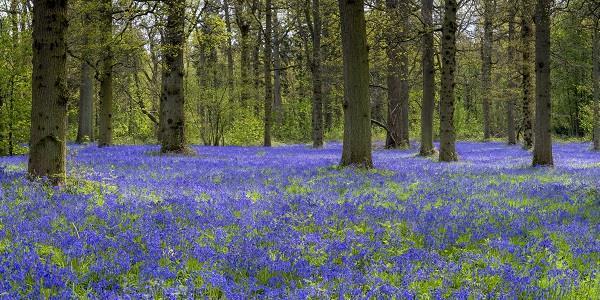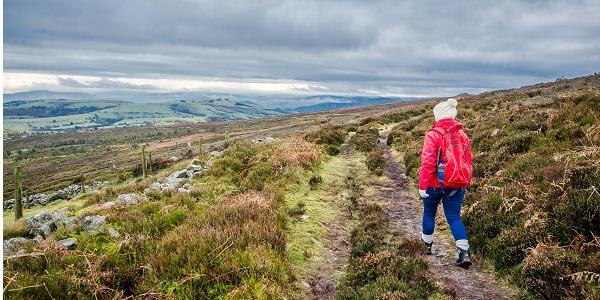
Norfolk is well known for its spectacular scenery and countryside, but visit at the right time and you could take these wonderful views to a whole new level. At certain times of the year, Norfolk puts on a breathtaking display, bursting with colour and texture, as the wildflowers come into bloom. From swatches of bluebells to mountains of lavender, these are some of the most stunning displays in the region. And with most less than an hour’s drive from our Barnham Broom property, there’s no reason not to get out and enjoy nature at its most colourful.
Snowdrops at Walsingham Abbey
Mid-winter, 40 minutes from Barnham Broom.
In the cold of winter, the grounds of Walsingham Abbey come to life. The 18 acres of woodland becomes carpeted with snowdrops.
First brought to the British Isles by the Romans, these delicate little flowers didn’t become really fashionable until the 17th and 18th Centuries. These days, snowdrops are commonly found growing in former abbeys and priories, where they are thought to have been planted due to the way their flowering correlates to the religious calendar. The flowers bloom in early February, which commemorates the ritual purification of the Virgin Mary 40 days after the birth of Christ, as well as the presentation of the baby Jesus in the Temple at Jerusalem.

Waslingham’s grounds create the perfect conditions for snowdrops to flourish; a well-lit, deciduous woodland with chalky, alkaline, humus-rich soil. There’s also good drainage, but the earth never dries out in summer. This means there are a large variety of snowdrops here, including the common galanthus nivalis and the double galanthus nivalis ‘flore pleno’. There is also a growing collection of less common varieties, including the large ‘Colossus’ and the self-explanatory ‘Tiny Tim’.
The Abbey opens its Snowdrop Walks between the end of January and start of March each year. Adult tickets cost £5.50. Find out this year’s dates on their website.
Sea Lavender at Burnham Overy Staithe
July to October, 50 minutes from Barnham Broom.
The secluded Burnham Overy Staithe Beach can be reached by just over a mile’s walk. But, if we’re honest, the walk is one of the best bits! You’ll wind your way through a wild, unspoilt march which, if you time your visit right, will be painted a breathtaking shade of mauve. The thousands of sea lavender flowers turn the whole area into a sea of colour. Combined with the fresh sea air and peace and quiet, the marshes really do have a unique feeling of tranquillity and calm. The walk to the beach can take up to 40 minutes, depending on your pace, but you’ll want to linger and drink in the surroundings for as long as possible!

Sea Lavender is one of the more dominant plant species in Norfolk’s saltmarshes, and one of four species which occur in the region. The plant is vulnerable in that it can only grow in this specific environment, but due to how well it thrives in these areas, there are no immediate concerns about its conservation.
Bluebells at Blickling Estate
April and May, 35 minutes from Barnham Broom.
Blickling’s gardens are always a haven of colour and texture, from tulips to crocuses. But the highlight of their floral calendar is certainly the dramatic bluebell display which bursts to life each year in Blickling’s Great wood. It’s a famous sight in the local area, and the National Trust take great care to ensure the flowers reach their true potential each year. This means careful coppicing and bramble clearing during the winter, allowing as much light as possible to reach the forest floor.
This kind of work is important due to the way bluebells grow. Firstly, the green leaves emerge in the winter, when the trees are bare and before leaves can block the light. This way they can do plenty of growing and replenish the nutrients stored in the bulb. The famous blue flowers appear at the end of the cycle and only last a short time before the plant dies back again. Bluebells also spread very slowly; these giant swathes of flora are a good sign that Blickling’s Great Wood has existed for many years – it’s even possible that woodland has existed here since the first trees after the Ice Age!

In 2019, Blickling is celebrating the return of its iconic bluebells by illuminating the exterior of Blickling house with a stunning blue light. For more information, including opening times and prices, visit the website.
Rhododendrons at Sheringham Park
May to June, 50 minutes from Barnham Broom.
Sheringham Park’s collection of rhododendrons is one of the best in the country. With over 80 species of rhododendron and azalea present in the garden, the dramatic displays of pink, red, purple, orange and yellow are truly striking. The displays are constantly changing throughout the season, so you can expect something different every time you visit.
It’s guessed that the first of the plants were introduced to Sheringham at around 1850 – these are now the tallest plants with red flowers. Plant collector Ernest ‘Chinese’ Wilson then added more seeds at the start of the 20th Century, greatly expanding the diversity of the collection.
All visitors to Sheringham can enjoy the flowers during May and June, simply by strolling down the main drive, where they take pride of place beside specimen trees from across the globe. If you’d like to take a deeper dive into the history and details of the displays, you can also book a tour of the garden with the Head Gardener. Find more information about this, as well as opening times and ticket prices, on the website.

Norfolk is certainly full of delights for nature-lovers, and these colourful landscapes are just the start. Barnham Broom is perfectly located to discover the best that the county has to offer, with rugged coastlines and unspoilt countryside within easy reach.
To find out more about how you can enjoy a stay at Barnham Broom, or request a brochure, simply get in touch.

